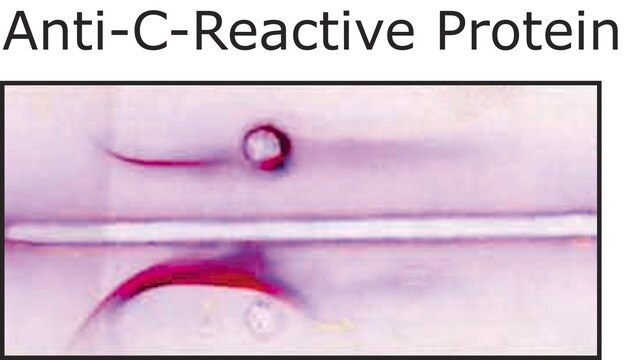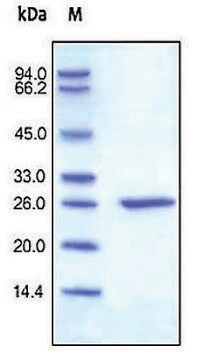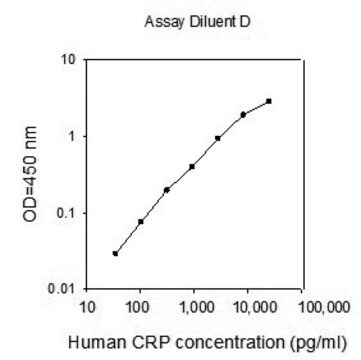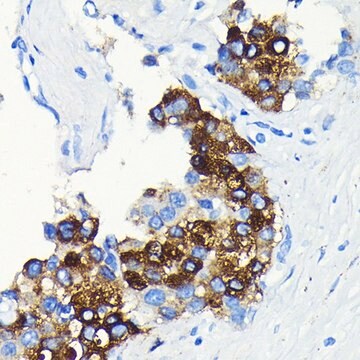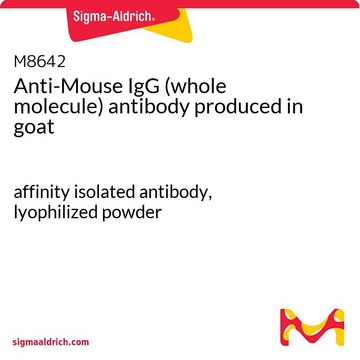C1688
Monoclonal Anti-C-Reactive Protein antibody produced in mouse
clone CRP-8, ascites fluid
Synonym(s):
Anti-CRP
Sign Into View Organizational & Contract Pricing
All Photos(2)
About This Item
Recommended Products
biological source
mouse
Quality Level
conjugate
unconjugated
antibody form
ascites fluid
antibody product type
primary antibodies
clone
CRP-8, monoclonal
mol wt
antigen 24 kDa
contains
15 mM sodium azide
species reactivity
human
technique(s)
dot blot: suitable
indirect ELISA: 1:40,000
western blot: 1:200
isotype
IgG1
UniProt accession no.
shipped in
dry ice
storage temp.
−20°C
target post-translational modification
unmodified
Gene Information
human ... CRP(1401)
Related Categories
General description
C-reactive protein (CRP) is a member of the pentraxin family of proteins and synthesized by the liver. It is also known as PTX1. The CRP gene is mapped to human chromosome 1q23.2.
Specificity
The antibody recognizes an epitope located on the 24 kDa subunit of denatured and reduced CRP. It does not cross-react with human serum amyloid P component (SAP), human haptoglobin, human α1-acid glycoprotein, human IgG, and CRP from Limulus.
Immunogen
human C-reactive protein.
Application
- It has been used in immunoblotting assay, to identify monomeric CRP.
- In time-resolved fluorometric assay.
Monoclonal Anti-C-Reactive Protein antibody produced in mouse is suitable for the following:
- dot blot analysis
- indirect ELISA at a working dilution of 1:40,000
- western blotting at a working dilution of 1:200
Biochem/physiol Actions
C-reactive protein (CRP) shows essential scavenging and metabolic activity and is also associated with defence mechanism. It activates the complement pathway by binding to calcium-dependent exogenous and autologous molecules containing phosphocholine (PC). It may have pathogenic effects and is a practical prognostic marker in patients with hepatocellular carcinoma (HCC). The CRP diagnostic value is higher for acute pyelonephritis than lower urinary tract infection. Thus, it helps in differentiating between upper and lower urinary tract infection. It is considered best for predicting the risk of cardiovascular disease..
Disclaimer
Unless otherwise stated in our catalog or other company documentation accompanying the product(s), our products are intended for research use only and are not to be used for any other purpose, which includes but is not limited to, unauthorized commercial uses, in vitro diagnostic uses, ex vivo or in vivo therapeutic uses or any type of consumption or application to humans or animals.
Not finding the right product?
Try our Product Selector Tool.
Storage Class Code
12 - Non Combustible Liquids
WGK
WGK 1
Flash Point(F)
Not applicable
Flash Point(C)
Not applicable
Choose from one of the most recent versions:
Already Own This Product?
Find documentation for the products that you have recently purchased in the Document Library.
Customers Also Viewed
C-reactive protein specifically enhances platelet-activating factor-induced inflammatory activity in vivo.
Sato A, et al.
European Journal of Pharmacology, 745, 46-51 (2014)
Aleksandra N Klisic et al.
Laboratory medicine, 45(1), 12-16 (2014-04-12)
Although C-reactive protein (CRP) is among the best cardiovascular disease risk predictors, data regarding the association of CRP and menopause are controversial. In this study, we measured CRP by a high-sensitivity method (hsCRP), cholesterol, lipoproteins, and triglycerides in normal and
Birgit Fendl et al.
Scientific reports, 11(1), 6996-6996 (2021-03-28)
There is increasing evidence that C-reactive protein (CRP) can mediate inflammatory reactions following the transformation of functionally inert pentameric CRP (pCRP) into its structural isoform pCRP* and into monomeric CRP (mCRP). This conversion can occur on the membranes of apoptotic
Rui-Ying Xu et al.
BMC urology, 14, 45-45 (2014-06-03)
Urinary infections are a common type of pediatric disease, and their treatment and prognosis are closely correlated with infection location. Common clinical manifestations and laboratory tests are insufficient to differentiate between acute pyelonephritis and lower urinary tract infection. This study
Akiyoshi Kinoshita et al.
Oncology, 86(5-6), 308-317 (2014-06-14)
C-reactive protein (CRP) is a practical prognostic marker in patients with hepatocellular carcinoma (HCC). We investigated the prognostic value of adding the CRP level to other validated staging systems (Cancer Liver Italian Program, Japan Integrated Staging, Barcelona Clinic Liver Cancer
Our team of scientists has experience in all areas of research including Life Science, Material Science, Chemical Synthesis, Chromatography, Analytical and many others.
Contact Technical Service

